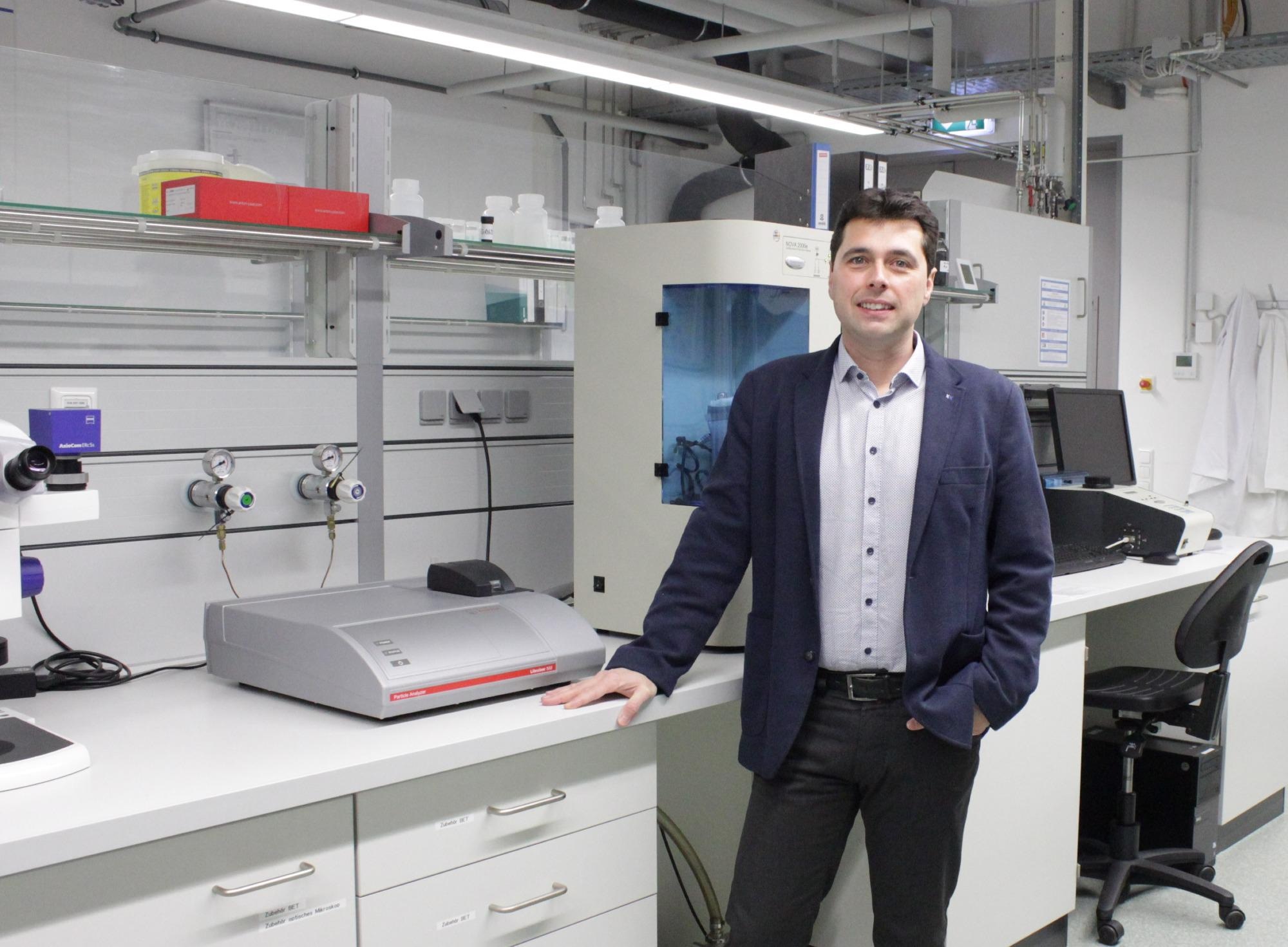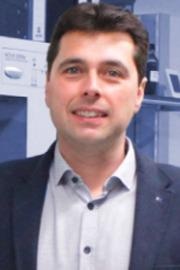 Interview conducted by Alex SmithFeb 25 2022
Interview conducted by Alex SmithFeb 25 2022
In this interview, AZoNano talks to Dr. Felipe Wolff-Fabris about the work he does for EZD, and how his partnership with Anton Paar is critical for testing and developing new nanomaterials.
The European Center for Dispersion Technologies (EZD) in Selb (Germany) is an interdisciplinary research and innovation center that specializes in the production and characterization of dispersions.
Activities involve contract research, public funded projects, analytical services and material testing, as well as on-site and online training. In collaboration with EZD, Anton Paar drives the high-precision measurement technology, organizes joint courses and works on joint challenging measurements and publications.
In this interview, EZD head Dr.-Ing. Felipe Wolff-Fabris discusses the focus and work of the EZD, the partnership with Anton Paar, daily tasks and challenges and his interesting career path.
The EZD emerged from the SKZ (German Plastics Center) as an interdisciplinary research and innovation center. The SKZ has a series of locations in Germany. Can you tell us a bit more?
The German plastics center SKZ was established about 60 years ago in Würzburg and has now 7 locations and around 430 employees across Germany. The SKZ is clearly focused on plastics – from testing to training, research and development.
In 2012, the SKZ decided to establish a new location in Selb, the so-called European Center for Dispersion Technologies (EZD). Here, the emphasis is on dispersing, which means we deal with the formulation, production and characterization of suspensions and emulsions.
What are the main scientific focuses of your institute currently, and what are your partners most interested in?
Dispersing is a fairly general and interdisciplinary topic, and so are the requests we deal with. However, we mostly focus on adhesives, coating systems and inks. Recently we’ve seen greater emphasis on resins for composite materials and also battery materials, for instance, suspensions for electrodes for electromobility.
Your website says your team has more than 90 years’ experience. How does this help the EZD position itself competitively?
Even though the EZD is a relatively young research establishment, we’ve already placed ourselves as the leading contact for dispersions. The principal reason for this is the unique scope of the three EZD pillars: formulation and recipe development, production and dispersion processes, and finally, yet just as importantly, characterization.
Simultaneously, our employees are vastly experienced in the areas of chemistry, technical engineering and physics – a total of more than 90 years. In order to further expand this experience level, maintaining good relations with our employees is crucial. Contrary to other research institutions, we offer permanent contracts, so we continuously increase our knowledge and know-how without a permanent employee change.
Our customers also recognize this important aspect because it means they can benefit from consistent support and fixed contact persons. I believe this combination of competences breadth and experience is what makes the EZD so attractive.
How did you end up at the EZD? What’s your background?

Image credit: Anton Paar
When the idea to set up the EZD first appeared in 2012, I moved over to SKZ to lead it. After building up a new building and laboratory facilities from the concept phase, we relocated to Selb in 2014. I’m Brazilian by birth, but before I ended up in northeast Bavaria, I did my Bachelor studies in material sciences in Brazil and then the Master in France.
In 2005, I arrived in Germany for the PhD in the area of resin formulation at the University of Bayreuth. It was in those circumstances that I acquired a lot of experience comprehensively dealing with the treatment and dispersion of nanoparticles.
Before heading the EZD in 2012, I also worked as a lab manager in the domain of composite materials for a couple of years at Henkel in Düsseldorf.
Anton Paar is a partner of the EZD. Why did you choose Anton Paar, and what does the partnership involve?
When the EZD was established, we started looking around for strategic partnerships, specifically for the development of new materials, for which precise and reliable characterization techniques are of critical importance. I was well aware that Anton Paar instruments offers both precision and reliability. But for a partnership, hardware alone is not enough.
In addition to good support, it is crucial to have the know-how of the instrument manufacturer and the willingness to exchange experiences, and that’s exactly what Anton Paar offers. Our alliance really got going through the direct support of Michael Schäffler from Anton Paar Germany.
He approached me, and we talked about areas of potential focus and the shape the partnership could take. It’s a win-win situation. We take advantage of borrowed instruments and a great deal of input, for instance, regarding the appropriate selection of measuring parameters.
On the other hand, we gain experience using the instruments, which we can then feed back to Anton Paar to translate into its development processes. We also jointly conduct seminars and publish our measurements and findings.
You cover materials research, product development, and process optimization. That requires some pretty rigorous research. How big is your lab? How many lab technicians do you employ? Which Anton Paar instruments do you use?
We have an excellent, innovative characterization lab that is very well equipped (https://www.ezd.eu/en/analytics), in which we have a range of focuses: characterization of dispersion stability, particle measurement technology, microscopy, thermal analysis, surface characterization, etc.
We utilize the instruments both for the development projects as well as for the measurement services that we carry out for a range of companies. We use Anton Paar’s rheometers, a dynamic light scattering instrument, and an adsorption analysis instrument. About ten people operate the instruments, including scientific personnel and technical staff.
Why did you choose Anton Paar instruments? What influenced such a decision?
Originally, we employed instruments from a range of manufacturers. This was initially driven by budget limitations. We now own a rheometer that we first borrowed from Anton Paar. That’s also how it was with the Litesizer, the particle analysis instrument that we purchased after the joint production of an application report.
The major difference with Anton Paar instruments is their unparalleled precision and reliability, as well as the straightforward exchanges and discussions we have with Anton Paar staff.
What do you like about working with Anton Paar instruments?
At the risk of repeating myself, we’re thrilled by the precision measurement results Anton Paar instruments offer. The repeatability of measurements is of utmost importance, particularly in development projects.
We are aware that that measurement results with Anton Paar instruments are exact and that we can completely rely on them – my colleagues would say and value the exact same thing.
Also, with other instruments, there are frequently issues that crop up, for example, with Windows system adjustments. We’ve never suffered that when using Anton Paar software and instruments. They’ve always worked as they should. Especially with the rheometer, we appreciate the modularity and versatility of the equipment.
For instance, we employ a UV measuring cell and a powder measuring cell as accessories, which is not even an option from other rheometer manufacturers. Such modularity allows us fulfilling specific requests made by the companies that we work with. I see significant growth potential in powder rheology, which is becoming more and more widespread across the industry.
How do Anton Paar instruments help you overcome specific challenges?
Specifically, we use the Litesizer in the context of new materials for battery technology – this is a market that has seen rapid expansion in the last two years. We measure suspensions with nanoparticles and investigate the particle/agglomerate size distribution.
Through the application of a UV cell for our MCR rheometer, we characterize UV-curable inks for the packaging industry. The aim is to make sure that such inks do not migrate after crosslinking. In other words, we want to prevent ink components from leaking into food products.
We use the MCR powder cell for the investigation and development of powder coating materials, an alternative to wet coating. Powder coatings are employed when high durability is required or when issues with solvents or other volatiles of wet paints should be avoided.
The EZD performs the modification and development of these powder coating materials, and with the powder cell, we’re able to distinguish their fluidization potential and flow characteristics extremely well.
How does Anton Paar complement this process?
Michael Schäffler, who is my primary contact, puts me in direct contact with the relevant expert in the various fields at Anton Paar.
Your parent company is SKZ. One of the pillars of its vision is that you stand for innovation and sustainable development. How do Anton Paar instruments contribute to the realization of this vision?
In cooperation with small and medium-sized companies we carry out research and development closely related to applications – so no fundamental research. We’re members of the Zuse community whose motto is, “Research that matters.”
Through our development work, we want to support German and European companies and boost their competitiveness. That’s our primary objective and also clearly our mission. Moreover, we want to contribute to innovation that can face the global and societal challenges of our age. Using Anton Paar instruments, we’re in a position to offer such assistance with great expertise.
Well-functioning analysis instruments are needed to first understand the basic structure and characteristic relationships of materials in order to further develop them. If we didn’t have the support of Anton Paar instruments, we wouldn’t be able to do this. We’d be operating on a trial-and-error basis, and progress would take a lot longer.
You offer individual training related to various topics. How does this training work? And what role do Anton Paar instruments play?
We deliver two types of training. For the first, we tailor individual training sessions to a company’s needs, a kind of training “a la carte”. Here, the company can choose its own specific modular training from different topics we offer (www.ezd.eu/en/training).
For instance, we have a particular module on the topic of rheology, specifically on the flow behavior of suspensions, where both the fundamentals of rheology and the measuring methods are covered. If required, a hands-on experience with the instrument can also be carried out.
We also offer a module on particle measurement technology with the Litesizer and dynamic light scattering (DLS).
The second kind of training we offer is on-location courses, including those in collaboration with Anton Paar, which cover color and pigment dispersions. These courses include lectures delivered by both our experts and those from Anton Paar.
The content is theoretical but often connected to images and videos of the measuring methods seen in the laboratory.
What findings have particularly impressed you over the years? What were the projects where you felt you really moved the ball forward? What particular customers did you help? What were your most successful partnerships?
Topics that are of great significance to me are those that position us, as society, being able to tackle major challenges. Firstly, over the last year, we’ve been working with companies on anti-microbial surfaces, which is crucial in the context of the Covid pandemic.
These anti-bacterial and anti-viral surfaces will be used, for example, in hospitals, where combating multi-resistant germs is a high priority.
We’ve also been consistently involved in developing sustainable products and eco-friendly materials for inks and paints. Here, our goal is to avoid substances that are harmful to health and the environment, and we want to substitute them with safer components without negatively impacting the quality of the end product.
Finally, I would like to mention battery technology. I’m delighted to say we are also able to contribute to more powerful, lighter batteries, which offer longer ranges and higher power density in electromobility –a key step in the direction of net-zero emissions.
What does the future hold for EZD? Are there plans for further development or expansion?
Thanks to financial support from the Bavarian state ministry for Economic affairs, Regional development and Energy, we were able to establish the EZD, a non-profit organization, and we now are about to expand both physically (new building) and in terms of areas of focus.
The expansion of the EZD, which will be concluded in 2023, means additional 20 employees, a modern lab for the coating and characterization of surfaces as well as a state-of-the-art technical-scale dispersion facilities. This will let us increase our industry-aligned research and development as well as offer a vast array of solutions ranging from raw materials to application. Our goal is to further support companies on accelerating their product innovation process.
Further details:
Anton Paar is pleased to now offer a 24/7 applications and research database for nanomaterials research and nanomaterials in final products, featuring specific research cases, application reports, and instrument information. You’ll get an up close look at how Anton Paar instruments are powering the curiosity of researchers who are building the future.
100 years at the forefront of analytical instrumentation. We empower scientists around the globe so game-changing science finds answers to humanity’s biggest challenges. This means outside-the-box ideas from people who don’t just defy the status quo, but reshape it. At Anton Paar, we think the unthinkable to create the exceptional. For you. Every day anew, since 1922. And Together, we measure the world. When Mr. Anton Paar founded the Austrian-based company, it was just the first step of a long journey. Since then Anton Paar has continuously explored – and determined – new ways to merge high-precision engineering with scientific curiosity. We’re ready and excited for the next chapter. The next 100 years.
About Dr. Wolff-Fabris
Dr. Felipe Wolff-Fabris was born in Brazil and received his bachelor's in materials science in Brazil at the University Federal do Rio Grande do Sul and his Master's degree in France at the Ecole Centrale Nantes. He received his Ph.D. in the area of resin formulation at the University of Bayreuth (Germany) in 2009 and also worked as laboratory manager at Henkel in Düsseldorf (Germany).
Since 2012 he is heading the EZD (European Center for Dispersion Technologies) in Selb (Germany).


This information has been sourced, reviewed and adapted from materials provided by Anton Paar GmbH.
For more information on this source, please visit Anton Paar GmbH.
Disclaimer: The views expressed here are those of the interviewee and do not necessarily represent the views of AZoM.com Limited (T/A) AZoNetwork, the owner and operator of this website. This disclaimer forms part of the Terms and Conditions of use of this website.